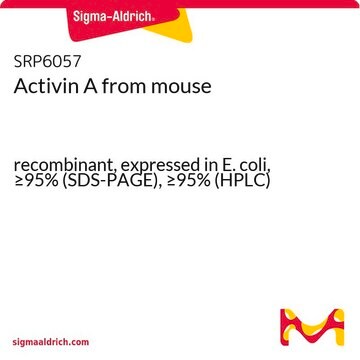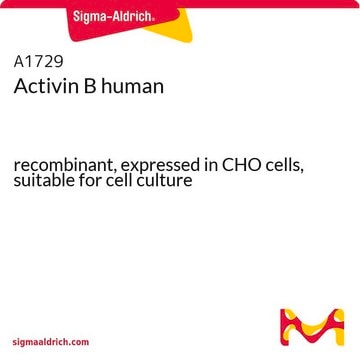H4666
Activin A human
recombinant, expressed in HEK 293 cells, HumanKine®, suitable for cell culture
Sinónimos:
Activin A Protein, Growth Factor, Human Activin A
About This Item
Productos recomendados
biological source
human
Quality Level
recombinant
expressed in HEK 293 cells
assay
≥95% (SDS-PAGE)
form
lyophilized powder
potency
≤5 ng/mL EC50
quality
endotoxin tested
mol wt
dimer 25 kDa (non-glycosylated)
packaging
pkg of 5x10 μg
pkg of 10 μg
technique(s)
cell culture | mammalian: suitable
impurities
≤1 EU/mg
storage temp.
−20°C
¿Está buscando productos similares? Visita Guía de comparación de productos
Biochem/physiol Actions
Activin-A stimulates glycogenolysis in isolated rat hepatocytes, Mine T ET. al. (1989) and elevates insulin release from rat pancreatic islets, Verspohl EJ et al. (1993). Activin-A stimulates insulin secretion in rat pancreatic islets, Totsuka Y, et al. (1988).
Follistatin, an activin-binding protein, is a principle regulator of activin activity, de Winter JP, et al. (1996); however during embryogenesis, Cripto is an important noncompetitive activin antagonist that facilitates Nodal signaling, Kelber JA, et al. (2008).
A role for activin-A as a regulator of cell proliferation was recognized by Gonzalez-Manchon C and Vale W. (1989); wherein Act-A inhibited the growth of and induced morphological changes in CHO-KI cells in culture, in a way similar to but less potent than TGF-β.
Activin A is involved with the entire process of embryo development from germ cells thru embryonic development to adult tissues. It stimulates spermatogonial proliferation in germ-Sertoli cell cocultures, Mather JP, et al. (1990) and is a maturation factor for oocytes, Itoh M, et al. (1990). Activin A promotes proliferation of human luteinized preovulation granulose cells (ovarian granulose cells), Rabinovici J, et al. (1990).
Analysis Note
Legal Information
Storage Class
11 - Combustible Solids
wgk_germany
WGK 3
flash_point_f
Not applicable
flash_point_c
Not applicable
Certificados de análisis (COA)
Busque Certificados de análisis (COA) introduciendo el número de lote del producto. Los números de lote se encuentran en la etiqueta del producto después de las palabras «Lot» o «Batch»
¿Ya tiene este producto?
Encuentre la documentación para los productos que ha comprado recientemente en la Biblioteca de documentos.
Nuestro equipo de científicos tiene experiencia en todas las áreas de investigación: Ciencias de la vida, Ciencia de los materiales, Síntesis química, Cromatografía, Analítica y muchas otras.
Póngase en contacto con el Servicio técnico







